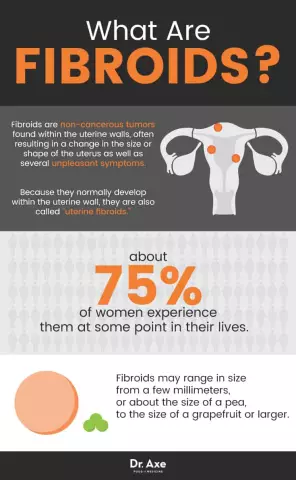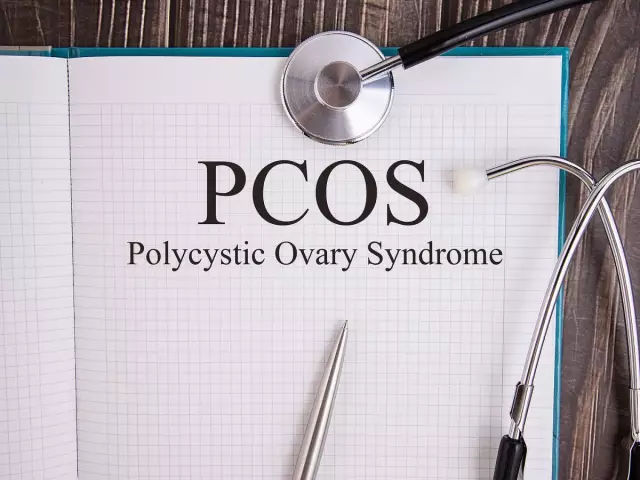- Author Rachel Wainwright [email protected].
- Public 2023-12-15 07:39.
- Last modified 2025-11-02 20:14.
Polycystic ovary syndrome

A syndrome is a collection of symptoms. That is, the signs of a certain disease are determined, which develop either in a certain sequence or simultaneously. It is important that they all manifest themselves in a pathological process. As a rule, the sum of clinical signs is typical for many diseases. Therefore, the syndrome is presented as a separate nosological form. At the same time, diseases are not indicated, since their causes are either completely different or unknown, as in the case of polycystic ovary syndrome, which was first described by scientists Stein and Leventhal. Subsequently, based on the pathological picture, this syndrome was designated as ovarian sclerocystosis. Today, the World Health Organization has finally consolidated the term - polycystic ovary syndrome, recommended for doctors around the world. In addition, due to the improvement in the diagnosis of diseases, the reason for the development of such a condition is already known.
Development of polycystic ovary syndrome: treatment
The main problem that contributes to the development of polycystic ovary disease is insulin resistance. This is a condition in which cells and tissues lose their ability to absorb glucose. At the same time, the amount of insulin initially remains sufficient. Then its production by the pancreas is reduced due to exhaustion. Disabling insulin receptors increases the sensitivity of tissues to adrenocorticotropic hormone, which triggers the mechanism of glucose production inside the body. For organs suffering from a lack of glucose, such a measure is compensatory. But, the increased release of adrenocorticotropic hormone stimulates the production of luteinizing hormone. And he, in turn, acts on the ovarian tissue, which leads to an increased synthesis of male hormones. The follicles that appear do not turn into eggs,and polycystic ovary syndrome is formed, the treatment of which is aimed at inducing ovulation.
Methods for the treatment of polycystic ovary:
- Surgical;
- Metabolic;
- Hormone.
The first treatment for polycystic ovary syndrome was surgery. It was believed that the thickened membrane of the ovary does not allow the egg to go beyond its limits. Therefore, a method of ovarian tissue resection was proposed. The ovarian tissue was cut out in a conical manner, with a large capture of the membrane and a smaller one - the stroma of the organ. As a rule, after such an intervention, the synthesis of progesterone, the main hormone of pregnancy, without which ovulation is impossible, increases sharply.
Today, surgical treatment of polycystic ovary syndrome is considered an extreme measure when all other methods do not bring a positive result. Modern operations are performed using a laparoscope, with much less ovarian tissue removed (ovarian drilling). However, even such operations should be refrained from, since surgery increases metabolic disturbances. In addition, there is a high risk of cardiovascular disease after ovarian resection. After such an intervention, the ovarian reserve is lost, which, inevitably, entails a premature menopause.
Metabolic therapy for polycystic ovary syndrome is aimed at increasing the sensitivity of cells and tissues of the body to insulin. Drugs are used that promote the absorption of glucose from the blood, inhibit the production of its own carbohydrates in the liver and inhibit the absorption of glucose in the stomach. These are biguanides, which are used in the treatment of type 2 diabetes.
Hormonal treatments are used to reduce androgen production and stimulate the release of the egg. Of course, the latter goal is pursued in the fight against infertility.
Polycystic Ovary Syndrome and Pregnancy
Since the absence of ovulation is due to low levels of progesterone, the main hormone of pregnancy, conception is impossible in polycystic ovary syndrome, and pregnancy does not occur even if there is monthly bleeding, which, in fact, is not menstruation.
On ultrasound, enlarged ovaries with a "necklace" consisting of many follicles, but without the main (dominant) one, which turns into an egg, are determined. When, as a result of hormonal or metabolic therapy, an egg is nevertheless formed, all other follicles from the "necklace" fall down and go into the reserve.
Therefore, when the treatment is effective, we are not talking about polycystic ovary syndrome, and pregnancy develops according to a known mechanism. Any factors can be the cause of the threat of miscarriage, but not the state of the follicles in the ovaries.

Pregnancy occurs after taking Siofor (Metformin) for six months. Or after induced ovulation, the stimulation of which for more than three months in a row is categorically contraindicated. Further impact on ovarian tissue does not have the desired effect, but increases the risk of an oncological process.
Polycystic ovary syndrome: treatment with folk remedies
As a rule, traditional medicine pursues a specific goal, therefore, treatment with non-traditional or traditional means for polycystic ovary syndrome is aimed at combating infertility and uterine bleeding caused by endometrial hyperplastic processes.
Vitex, or Abraham's tree, stimulates the production of progesterone, thereby causing ovulation. It is recommended to take a decoction or alcoholic infusion of Vitex fruits daily for three months. However, in practice, ovulation occurs in the next cycle.
With polycystic ovary syndrome, treatment with folk remedies that improve liver function, helps to normalize metabolism.
YouTube video related to the article:
The information is generalized and provided for informational purposes only. At the first sign of illness, see your doctor. Self-medication is hazardous to health!






